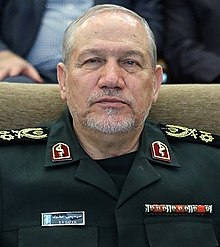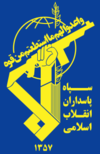Yahya Rahim Safavi
Yahya Rahim Safavi | |
|---|---|
 | |
| Born | 1952 (age 72–73) Isfahan, Pahlavi Iran |
| Allegiance | Iran |
| Service | Islamic Revolutionary Guard Corps |
| Years of service | 1979–present |
| Rank | Major general |
| Commands | Islamic Revolutionary Guard Corps Ground Forces |
| Battles / wars | |
| Awards | full list |
Yahya "Rahim" Safavi (Persian: یحیی (رحیم) صفوی, born 1952) is an Iranian military commander who served as the chief commander of the Islamic Revolutionary Guard Corps.[1][2]
Early life
[edit]Safavi was born in 1952 in the city of Isfahan, Iran.[1][2]
Career
[edit]Safavi was one of the leaders of the Iran–Iraq War.[3] During the US-led invasion of Afghanistan, he played a key role in the uprising in Herat in November 2001, where American, Iranian and Northern Alliance troops supported a local uprising against the Taliban.
He served as the deputy commander of Islamic Revolutionary Guards Corps until 1997 when he was appointed its commander, replacing Mohsen Rezaee in 1997.[4]
He was replaced as commander of the IRGC by Mohammad Ali Jafari, former director of the Strategic Studies Center of the IRGC on 1 September 2007.[5] Then he was appointed by the Supreme Leader, Ali Khamenei as his special military advisor.[6]
Asset freeze
[edit]On 24 December 2006, Rahim Safavi was included on a list of Iranian individuals and organizations sanctioned by the United Nations Security Council Resolution 1737 due to their alleged involvement in the Iranian nuclear and ballistic missile programmes.[7]
Awards and recognition
[edit]See also
[edit]References
[edit]- ^ a b "Sayyid Yahya Safavi". tasnimnews.com. 30 January 2019.
- ^ a b "Seyyed Yahya Rahim Safavi". basirat.ir. 30 January 2019.
- ^ Safavi, Karbala 5 Operation iribnews.ir Retrieved 31 January 2019
- ^ Rubin, Michael (Fall 2008). "Iran's Revolutionary Guards – A Rogue Outfit?". Middle East Quarterly. XV (4): 37–48. Retrieved 13 August 2013.
- ^ Sepehri, Vahid (4 September 2007). "Iran: New Commander Takes over Revolutionary Guards". Radio Free Europe. Retrieved 13 August 2013.
- ^ Frederic Wehrey; Jerrold D. Green; Brian Nichiporuk; Alireza Nader; Lydia Hansell; Rasool Nafisi; S. R. Bohandy (2009). "The Rise of the Pasdaran" (PDF). RAND Corporation. Retrieved 20 August 2013.
- ^ "Security Council imposes sanctions on Iran for failure to halt uranium enrichment, unanimously adopting Resolution 1737". United Nations. Archived from the original on 18 May 2012.

